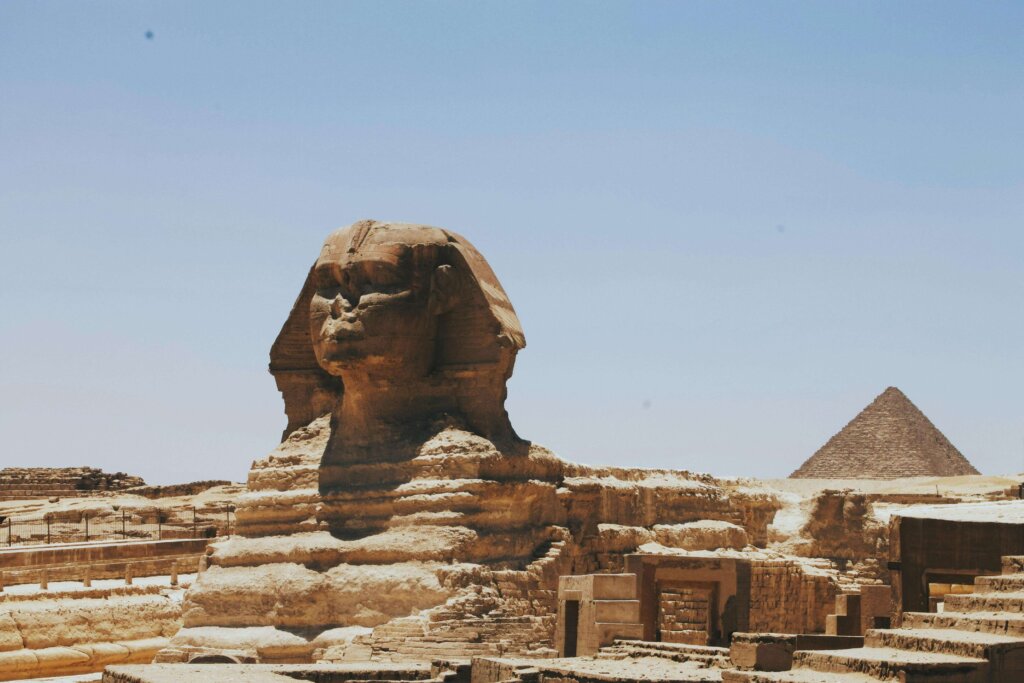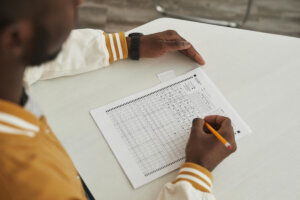Some people say that acing the AP World History exam is quite a challenge. However, it doesn’t have to be too hard for you. With the right approach to preparation, proper materials, and AP World History tips, studying may be fascinating. But what should you do to truly succeed on the exam? Is there a crash course you should know about? Keep reading to get all the answers!
What Is the AP World History Test?
So, let’s start by clarifying what the test itself is all about. The AP World History Modern Exam checks how well you know the historical events and concepts you’ve learned in class. It also tests if you are able to analyze sources, find patterns, and define historical context. In other words, testing goes beyond just checking your knowledge of facts and dates; you need to know ways of interpreting what was happening in a particular era and see a bigger picture.
The actual exam consists of the following parts:
Source: The College Board
Before you start wondering how to study for the AP World exam, make sure you understand its structure. Let’s check the sections it contains:
Section I, Part A: Multiple-Choice
- 55 multiple-choice questions come in sets of 3 to 4 questions.
- Each set comes with one or more stimuli (e.g., historical texts, interpretations, pictures, graphs, maps, etc.)
- Students have to analyze the stimulus sources and the corresponding historical periods or events.
Section I, Part B: Short Answer
- This part has 3 required short-answer questions.
- Question 1 includes a secondary source stimulus. This short-answer question will be based on a historical process between 1200 and 2001.
- Question 2 has a primary source stimulus. Its topic will also cover the historical developments between 1200 and 2001.
- As for the third required question, you can select between questions 3 and 4. Neither of them includes a stimulus. The major difference, though, is that Question 3 focuses on historical processes between 1200 and 1750 while Question 4 – between 1750 and 2001.
- All your answers have to fit in the dedicated space of your answer sheet.
Section II: Document-Based Question
- You will get a prompt (aka your task) to analyze a historical event or process and 7 documents containing different perspectives on that event/process.
- Your task is to write an essay in response to the prompt.
- You should use the provided documents as well as your knowledge to support your argument.
- Also, you have to explain the purpose, point of view, audience, and historical context relevant to at least three of the seven documents.
- The document-based question centers on topics in the period from 1450 to 2001.
Section II: Long Essay
- You will need to respond to a prompt, supporting the argument and showing the broader context.
- You have to select one of the three topics. All question options require the same skills and thinking process (like comparing, explaining causes, or analyzing changes). But each prompt will focus on different periods in history:
- Option 1 – years 1200–1750
- Option 2 – years 1450–1900
- Option 3 – years 1750–2001
You must be prepared for all of these sections to get a high score. As you see, apart from knowing the basics, you will also have to show critical thinking and interpretation skills. What is your preparation supposed to include? Let’s find out.
Preparation Tips: How to Pass AP World History Exam
If you want to make the best of your test, you should do more than just know each AP World History unit; you need to practice questions, find the correct short answers, and understand how small details affect bigger processes. Here’s what else you can do:
Study Time Periods
Some students think they should just memorize dates and facts, and that will be enough. But it is not true, at least not for the AP World History exam. The College Board has created the test to be more about understanding the context of different time periods than remembering mere facts.
For each period, you have to know the main factors that influenced politics, economics, and social/technological changes in the then-existing countries. But you don’t have to memorize every single detail to do well on the test. Instead, focus on understanding the bigger picture, identify the reasons and consequences of events, and practice explaining them with a few key examples.
Source: The College Board
Read Intently and Make Notes
This one seems like easy advice. Still, it is crucial. Keep up with your reading for the World History class to ensure you’re building a strong foundation of knowledge. This way, when spring comes, you can focus on preparing for the exam itself, particularly on the topics it’s likely to test, as opposed to frantically trying to learn almost a thousand years of human history in just two months.
If you make notes during the whole year, or at least a bigger chunk of it, you will be able to navigate historical events better than if you were just reading. Highlighting key ideas and events will help you a lot. Besides, you will keep major dates, trade routes, and other details in your memory for longer just because you’ve engaged in the process of writing that information.
Familiarize Yourself With the Main Themes
There are six main themes you need to know for the exam. They are like the glue that holds the course together. You should be able to make meaningful connections between different events and historical processes. They’re usually big ideas that are woven throughout the entire course, appearing again and again. By revisiting these themes and applying them in context, you can gain a better understanding of each concept.
Source: The College Board
Practice Essay Writing Using a Timer
Writing an essay quickly and without preparation is quite difficult. So, make sure you practice doing that under time limitations. What should you know well? Each essay needs a clear central idea, called a thesis. Put this at the end of your intro paragraph. But first, try to sketch all the key concepts.
Organize your essay neatly. Each paragraph should focus on one part of your argument. Start each paragraph with a topic sentence, which is like a mini-thesis. If you’re slow at writing, practice with easier topics. Set a timer and write as much as possible in 10-15 minutes. Count the words to track your progress, and write essays regularly to become more efficient at it.
Understand Task Verbs in Free-Response Questions
Once you take the exam, you might get confused with the task itself. How to study for AP World History tests to avoid that confusion? The answer is simple: get familiar with what awaits you and analyze the task verbs. Make sure you understand them when answering free-response questions. Here’s what each one means:
- Compare. Show similarities and/or differences between things, concepts, periods, etc.
- Describe. Provide the important characteristics of something.
- Evaluate. Judge the significance or quality of information, claim, statement, etc.
- Explain. Give details on how or why something happens, using evidence or reasoning. There are two types of these questions (“how” and “why”):
- Explain “how” will normally require you to analyze any process, pattern, situation, or outcome.
- Explain “why” will normally require you to analyze reasons or motivations behind any process, pattern, situation, or outcome.
- Identify. Point out or give information about something without going into detail.
- Support an argument. Give examples and explain how they back up a claim.
Try to Be Consistent for the Whole Year
Actually, it can easily be the number one tip for passing the exam. When you study history (or whatever, really), you have to be really consistent. Otherwise, you will lose progress very quickly. Learning about technology, trade, power, or religion across the centuries is easier if you study consistently throughout the year.
Learn How to Interpret Art to Its Historical Era
Get to know how experts talk about art by visiting an art museum. Pay attention to how they describe the art. Thus, you’ll understand how to interpret what the artist means or how a painting reflects history. This step isn’t required, but it’s a helpful way to prepare for the test. The art itself can tell us a lot about the time when it was created.
SAT studying with cutting-edge tech
Prep for the PSAT, SAT, or ACT with Acely, our AI powered test prep tool. Get a personalized study plan, question hints, explanations and performance data to help you reach your test goals.
Top Advice for the Exam Day
On the test day, anxiety and stress due to taking a long-awaited test may affect you negatively. So, how can you ensure these feelings will not impact your results? If you’re wondering how to pass the AP World History exam, these tips can be a big help for you:
- Keep track of time. Watch the clock so you don’t waste too much time on one question. You may give too much attention to a single question, but it isn’t the best strategy. Instead, answer the questions that seem easy to you and leave harder ones for later. You can then come back to those questions and try to answer them. If you finish early, don’t forget to review your work.
- Work through your evidence and thesis statement. Writing essays is a big part of your exam, so pay special attention to it. First, make sure you understand the prompt. Then, think about what proof you can use to support your claims. Look back at what you’ve learned and identify what relates to the prompt and how it fits into your answer. Does it show something similar or different? Does it support or oppose a general idea?
Once you’ve decided on your evidence, identify the main idea, which is a thesis statement. It will guide your writing and keep you focused. Now, start writing. Make your main argument, then use evidence to back it up. Be clear about your ideas and show how they connect to your main statement. Avoid vague arguments and stay on track with your thesis.
- Elaborate on the evidence. When explaining your proof, don’t just repeat it. Instead, describe why it matters and how it strengthens your argument. If there’s evidence that goes against your point, address it and explain why your argument still holds up. This shows that you understand the nuances of the topic.
To better understand these rather complex nuances, you can hire a tutor. Under the guidance of a professional, it might be much easier for you to learn these things.
Conclusion
The AP Modern History test covers different historical periods. It evaluates students’ understanding of how technology has evolved and influenced human development, involving changes and continuities. It may seem hard at first, but if you consider our AP World History exam tips, you’ll increase your chances for success. All the luck!





